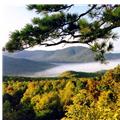文章信息
百寿乐园
百寿乐园Longevity Paradise
日月峡的百寿乐园中有一条长长的百寿路,上面有108个用黑白鹅卵石拼出的篆书体“寿”字,用于足底按摩,也象征着通过这样的运动获得健康长寿。沿着生的方向,每走出一个字,象征着增长一岁,路的两边有一些相关年龄称谓的石刻,可以通过这些了解古代年龄称谓的文化。
There is a lengthy path of longevity bearing 108 characters ‘寿’ (longevity) at Longevity Paradise of the Sun-Moon Canyon National Forest Park. These characters in the zhuan (篆) or seal script of the Chinese calligraphy are made of black and white cobblestone. Walking on them serves as having a foot reflexology and also symbolizes obtaining a healthy longevity through such exercise. Following in the anti-clockwise direction means a new life is born. And walking on every character symbolizes one year is older. On both sides of the path, there are engraved stones depicting the ancient cultures about age.
There is a lengthy path of longevity bearing 108 characters ‘寿’ (longevity) at Longevity Paradise of the Sun-Moon Canyon National Forest Park. These characters in the zhuan (篆) or seal script of the Chinese calligraphy are made of black and white cobblestone. Walking on them serves as having a foot reflexology and also symbolizes obtaining a healthy longevity through such exercise. Following in the anti-clockwise direction means a new life is born. And walking on every character symbolizes one year is older. On both sides of the path, there are engraved stones depicting the ancient cultures about age.

长寿亭Longevity Pavilion(日月峡国家森林公园百寿乐苑)

百寿路Longevity Path(日月峡国家森林公园百寿乐苑
百寿乐园的外围,是由代表了释、儒、道的观音、孔圣、文曲以及笑对未来的弥勒组成的文化雕像群。这一系列的雕像和亭台是日月峡弘扬中国传统文化的重要体现。
Surrounding Longevity Paradise; is an array of cultural statues of Guan Yin, Confucius, Wen Qu and Maitreya Buddha; which represent Buddhism, Confucianism, Daoism and the unknown future respectively.
These statues and pavilions are the significant means of propagating the Chinese traditional cultures from the Sun-Moon Canyon.
Surrounding Longevity Paradise; is an array of cultural statues of Guan Yin, Confucius, Wen Qu and Maitreya Buddha; which represent Buddhism, Confucianism, Daoism and the unknown future respectively.
These statues and pavilions are the significant means of propagating the Chinese traditional cultures from the Sun-Moon Canyon.

观音像Statue of Guan Yin(日月峡国家森林公园百寿乐苑

孔圣亭Sage Confucius Pavilion(日月峡国家森林公园百寿乐苑

未来亭Maitreya Buddha Pavilion(日月峡国家森林公园百寿乐苑

文曲亭Wen Qu Pavilion(日月峡国家森林公园百寿乐苑
阅读 545
| 我也说两句 |
| 版权声明: 1.依据《服务条款》,本网页发布的原创作品,版权归发布者(即注册用户)所有;本网页发布的转载作品,由发布者按照互联网精神进行分享,遵守相关法律法规,无商业获利行为,无版权纠纷。 2.本网页是第三方信息存储空间,阿酷公司是网络服务提供者,服务对象为注册用户。该项服务免费,阿酷公司不向注册用户收取任何费用。 名称:阿酷(北京)科技发展有限公司 联系人:李女士,QQ468780427 网络地址:www.arkoo.com 3.本网页参与各方的所有行为,完全遵守《信息网络传播权保护条例》。如有侵权行为,请权利人通知阿酷公司,阿酷公司将根据本条例第二十二条规定删除侵权作品。 |
 m.quanpro.cn
m.quanpro.cn
